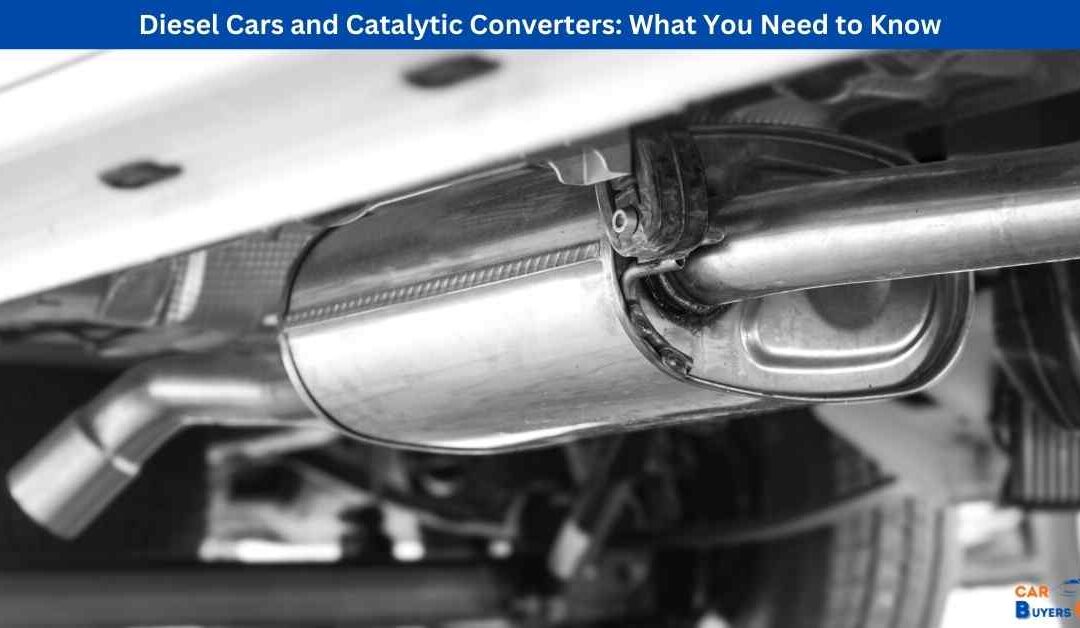Introduction
Modern automobiles must have catalytic converters because they are necessary for lowering emissions and preserving the environment. Before being released into the environment, these devices are intended to transform dangerous pollutants like carbon monoxide, nitrogen oxides, and hydrocarbons into less dangerous ones. Since several decades ago, it has been required for cars to utilize catalytic converters, but not all cars use the same kind of catalytic converter, which can be confusing for both car purchasers and owners.
We’ll talk about diesel vehicles and catalytic converters in this blog. We’ll look at whether catalytic converters are present in diesel vehicles, how they function, and how they affect emissions. We’ll also examine current laws and upcoming advances in catalytic converter technology. This blog’s purpose is to educate readers about catalytic converters and their significance in the fight against air pollution. Making educated choices regarding our vehicles is more crucial than ever, given the growing knowledge of the effects of car emissions on the environment and human health.
How Catalytic Converters Work
Catalytic converters are sophisticated devices that transform hazardous pollutants into less damaging ones through a catalytic chemical reaction. A ceramic or metal substrate covered in a catalytic substance, such as platinum, palladium, or rhodium, is the foundation of a catalytic converter. To boost the effectiveness of the catalytic reaction, the substrate is made to have a large surface area.
The catalytic converter functions by directing engine exhaust gases through the substrate, where the catalytic substance ignites a chemical reaction. The contaminants in the exhaust gases are changed into less dangerous elements including nitrogen, carbon dioxide, and water vapor. Because the catalytic converter works best at high temperatures, it is placed close to the engine, where the exhaust gases are hottest.
Although catalytic converters are quite good at cutting emissions, maintaining them properly does require routine maintenance. The catalytic substance may clog up with time, decreasing its effectiveness. In addition, exposure to certain substances, such as leaded gasoline, can harm catalytic converters. Catalytic converters can continue to function properly if they are regularly inspected and replaced.
Since they have been required in automobiles for many years, catalytic converters have significantly decreased emissions and enhanced air quality. They are beneficial to both the environment and human health because they lessen exposure to dangerous pollutants like nitrogen oxides and carbon monoxide.
Diesel Cars and Catalytic Converters
Diesel engines work and emit in a manner that is distinct from those of gasoline engines. Diesel engines use compression ignition, where the heat of the compression ignites the fuel as it is pumped straight into the combustion chamber. On the other hand, gasoline engines use spark ignition, which ignites the fuel-air mixture via a spark plug.
Compared to gasoline engines, diesel engines are more fuel-efficient and may generate more power. They do, however, also produce more nitrogen oxides (NOx), which are dangerous pollutants that help to cause smog and acid rain. Diesel particulate filters (DPFs), which remove soot from exhaust fumes, are included in diesel vehicles to lower NOx emissions.
Diesel cars also utilize catalytic converters, but they’re not the same as the ones used in gasoline vehicles. A diesel oxidation catalyst (DOC) or selective catalytic reduction (SCR) converter is a type of catalytic converter used by diesel vehicles to minimize NOx emissions. While the SCR converter employs a chemical reductant, usually urea, to turn NOx into nitrogen and water vapor, the DOC transforms hydrocarbons and carbon monoxide into carbon dioxide and water vapor.
Modern emissions control systems are installed in diesel vehicles, but to keep them operating efficiently, these systems need to be maintained frequently. The vehicle may not function correctly and may fail emissions testing if the DPF or SCR converter clogs. The emissions control systems in diesel vehicles can continue to function successfully with routine inspections, filter changes, and reductant refills.
The Role of Catalytic Converters in Diesel Cars
Diesel car emissions are significantly reduced by catalytic converters. A diesel oxidation catalyst (DOC) or selective catalytic reduction (SCR) converter is the kind of catalytic converter used by diesel vehicles, as was before described. These converters are made to lower nitrogen oxide (NOx) emissions, which are dangerous pollutants that cause smog and acid rain.
Carbon monoxide and hydrocarbons are transformed into carbon dioxide and water vapor by the DOC. The exhaust gases are directed through a ceramic or metal substrate coated with a catalytic substance, such as platinum, palladium, or rhodium, to produce the desired results. By triggering a chemical process, the catalytic material transforms the contaminants into less dangerous ones.
The SCR converter transforms NOx into nitrogen and water vapor using a chemical reductant, commonly urea. Injected into the exhaust stream, the reductant interacts with the NOx to produce nitrogen and water vapor. Although this method is quite good in cutting NOx emissions, it does need routine maintenance to keep it functioning properly.
The type of converter being used, how old the converter is, and the caliber of the catalytic material all affect how efficient catalytic converters are in diesel vehicles. Catalytic converters can continue to function properly if they are regularly inspected and replaced. Additionally, utilizing high-quality diesel fuel and avoiding low-quality fuels can both help the catalytic converter last longer.
In general, catalytic converters are essential for lowering diesel car emissions and enhancing air quality. They are an important component of diesel cars’ emissions control systems and need routine maintenance to remain functional.
Current Regulations and Future Developments
Since the 1970s, catalytic converters have been required in cars, and laws have been passed to guarantee that vehicles adhere to strict pollution standards. To cut pollution and enhance air quality, the California Air Resources Board (CARB) and the United States Environmental Protection Agency (EPA) have created emissions regulations for vehicles, especially diesel vehicles. Over time, these requirements have become more stringent, and manufacturers have had to create increasingly sophisticated emissions control systems to comply with the new requirements.
To lower emissions of nitrogen oxides and particulate matter, diesel vehicles are currently obliged to include a diesel particulate filter (DPF) and a selective catalytic reduction (SCR) converter. Although these systems are quite efficient, they do need to be maintained on a regular basis to make sure they stay that way.
Manufacturers are constantly creating new technologies to achieve these regulations as a result of a push for progressively stricter emissions limits in recent years. Exhaust gas recirculation (EGR) systems, which recirculate a portion of the exhaust gas back into the engine to lower combustion temperatures and minimize NOx emissions, are one example of such a development. Another innovation is the usage of hybrid powertrains, which combine internal combustion and electric engines to cut pollutants.
We may anticipate even more cutting-edge solutions being created in the future to reduce emissions from diesel vehicles. These might involve the creation of electric and hybrid powertrains, as well as the usage of alternative fuels like biofuels and hydrogen. Manufacturers are constantly attempting to meet the goal of reducing emissions and enhancing air quality.
Overall, catalytic converters are an essential part of diesel cars’ emissions control systems, and laws have been put in place to make sure that vehicles adhere to strict emission standards. To satisfy these regulations and substantially cut emissions in the future, manufacturers are constantly creating innovative technology.
Conclusion
Modern automobiles must have catalytic converters because they are necessary for lowering emissions and preserving the environment. Before being released into the environment, they are intended to transform dangerous pollutants like carbon monoxide, nitrogen oxides, and hydrocarbons into less dangerous ones.
We have covered the subject of diesel vehicles and catalytic converters in this blog. We have looked at the existence of catalytic converters in diesel vehicles, how they function, and how they affect emissions. Additionally, we examined upcoming advancements in catalytic converter technology as well as present laws.
A particular kind of catalytic converter used in diesel vehicles, known as a diesel oxidation catalyst (DOC) or a selective catalytic reduction (SCR) converter, lowers nitrogen oxide emissions (NOx). While the SCR converter employs a chemical reductant, usually urea, to turn NOx into nitrogen and water vapor, the DOC transforms hydrocarbons and carbon monoxide into carbon dioxide and water vapor. Although these systems are quite good at lowering emissions, they do need to be maintained on a regular basis to make sure they keep doing so.
Manufacturers are always creating new technologies to fulfill these standards and lower emissions even further in the future. Regulations have been put in place to ensure that vehicles adhere to specific emissions standards.
In conclusion, catalytic converters are an essential part of lowering diesel vehicle emissions and enhancing air quality. Understanding the significance of catalytic converters and the necessity for routine vehicle maintenance and inspection is crucial to ensuring their continued efficiency. In order to choose the right vehicle for us, it’s crucial to be updated about existing restrictions and potential advancements in catalytic converter technology.
If you are in South Melbourne, Victoria 3205, and looking for a car buyer service in Melbourne, below is the best way to visit us.
Car Buyers Online Melbourne
13 Dalgety St
St Kilda VIC 3182
(03) 4050 4974
www.buyersonline.com.au

